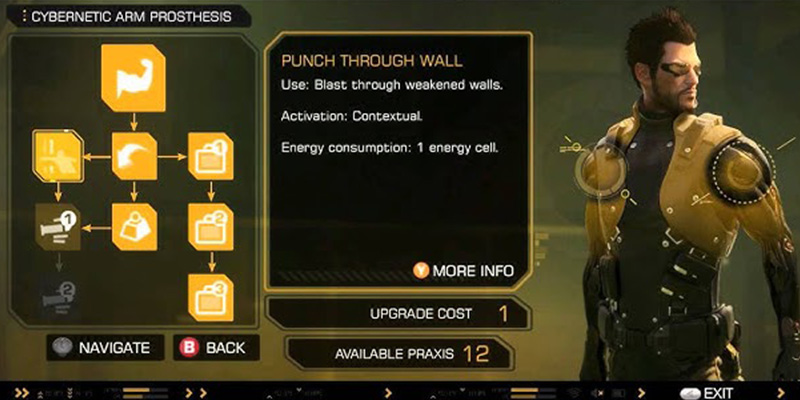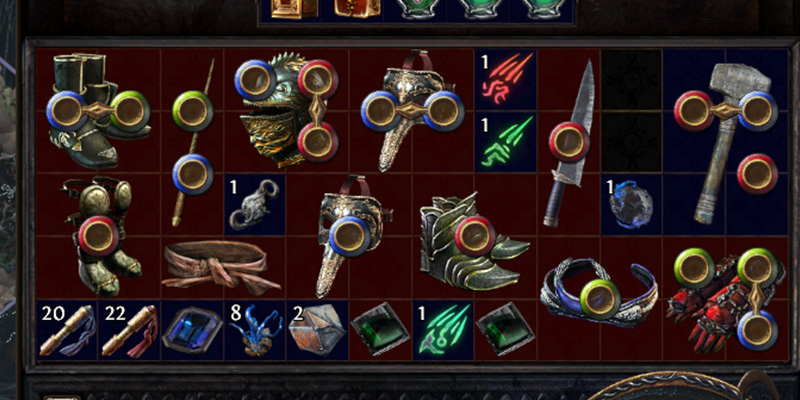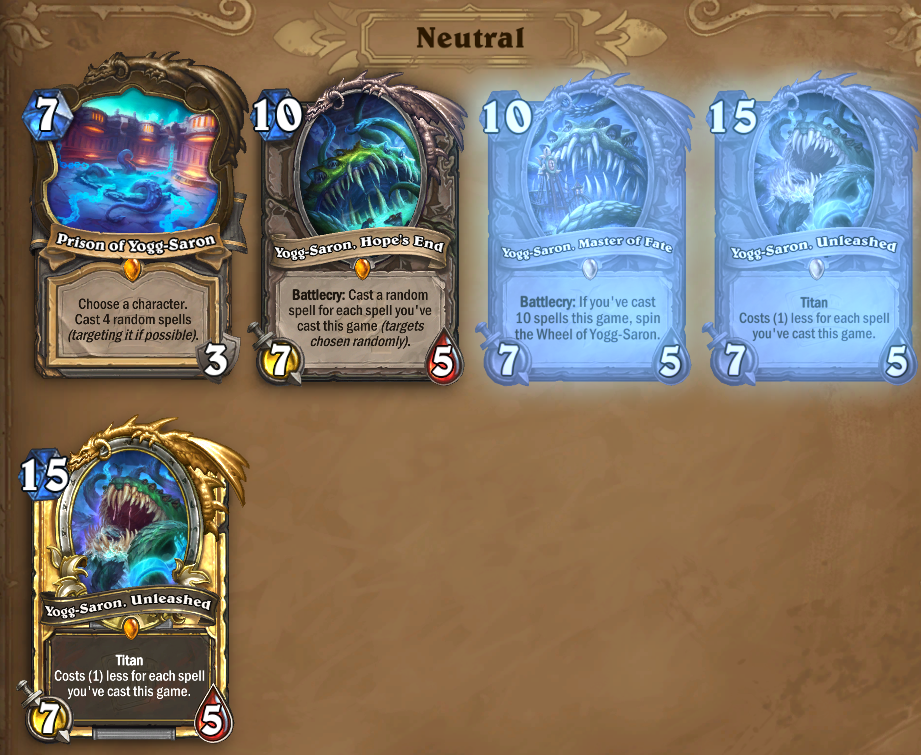If there's one thing the average player will bump against in most games they pick up, regardless of genre, it is some sort of inventory. Inventories come in all shapes and sizes, always created to fit the exact needs of the game they're being designed for. In fact, they are notoriously complex to implement because each game has different "inventory needs". There's no blueprint to creating the perfect inventory, because the inventory can only be perfect when it's matched to the appropriate game.
I'll be splitting this article into three parts. Make sure to look out for part 2 when it comes out!
In this article I'd like to go over a few common inventory designs and praise, critique or, well, just rant about them. There's lots of good eggs out there, but also plenty bad ones. I mean, consider for a moment all the "made-for-joysticks" inventories you've come across on a PC game that could have benefitted from a redesign. Even something as simple as a weapon / spell wheel could be regarded as a type of inventory, while simultaneously being a bad inventory system for mouse + keyboard. First, let's take a quick look at some of the common characteristics of inventories.
Common Inventory Needs, Wants & Limitations
What informs the final design of an inventory system - that is, what players get their hands on - is the nature of the game it is a part in. There's a tight relationship between inventory and items, loot, mechanics such as power, and just itemization in general. Let's see some examples:
- An inventory may be seemingly infinite (such as Skyrim) or finite based on the available items in the game (such as Hearthstone's collections).
- An inventory's size may be constrained by other factors instead, such as weight (Skyrim), premium subscription (Elder Scrolls Online), bag size (World of Warcraft) or upgrades (Deus Ex: Human Revolution).
- An inventory system could be divided up into several sub-inventories (Hearthstone's several collections, Skyrim's tabs that sort by item type) or it could be a free-for-all (World of Warcraft's bags, save the recently-added Reagent Bag, can fit any item in the game in whatever order you wish).
- Speaking of order, inventories could be ordered by the game (Hearthstone cards ordered by Mana cost, Skyrim's sub-inventories alphabetically), or allow the player to order items (World of Warcraft).

Deus Ex: Human Revolution's augmentation tree allows you to upgrade your inventory size three times.
At a base level, each inventory can allow or restrict player freedom depending on the context. There's nothing inherently wrong with the inventories I exemplified above, and certainly players' taste is varied enough for each iteration to have its fans. But what about informational distinctions?
- Inventories can be list-based, like in A Dark Room, or Skyrim (with a visual preview on the right, including stats, only when the item is selected).
- Inventories can be icon-based, like World of Warcraft, with a tooltip showing the item's stats only when the item is hovered over.
Additionally, we've also seen plenty examples of inventory layouts:
- The list, where reading item names is the main task players have while interacting with the inventory (Skyrim).
- The image list, where both the item's form as well as its stats are visible from the get-go (Hearthstone).
- The "visual horizontal list" (bear with me, I'm naming these on the fly!), used in games with small inventories, where all items are displayed, usually along with a keybind (Unreal Tournament).
- The grid, where seeing icons are what is used to inform the player of the nature of the item (World of Warcraft, DOTA).
- The, uhm, "Tetris grid", where each item takes up a specific amount of space and organizing your inventory is a mini-game (Diablo 2, Path of Exile, Deus Ex: Human Revolution).

Path of Exile's inventory is uniquely vintage, but its wonkiness adds another layer of depth to loot management.
Lastly, player interaction:
- An inventory can be immutable when the player has no say in the ordering of items (Skyrim, Hearthstone, Unreal Tournament, A Dark Room, Elder Scrolls Online).
- An inventory can be mutable when the player can order items at will (World of Warcraft, DOTA, Diablo 2, Path of Exile, Deus Ex: Human Revolution).
This is to say, there's an overwhelming amount of ways to design an inventory system, and equal ways to make it great, or not so great. The examples I've listed above merely scratch the surface of a deep, dark chasm of inventory types. Talking about all kinds of inventories would be a novel-sized book, but let's discuss some of the pros and cons of the most popular inventory implementations.
The List-like Inventories - Skyrim, Hearthstone, A Dark Room, Unreal Tournament
Perhaps, historically, the most "authentic" type of inventory considering most of us create an analog version of 'the list' every week before we go shopping. The list is inherently simple: The game automatically sorts all your items based on various parameters (most commonly alphabetically), and all you have to do is follow the road of letters or numbers until you hit your item destination. In the games we're using as an example, the sorting systems work as follows:
- Skyrim orders first by item type (weapon, food etc.), then each sub-inventory is sorted alphabetically. Item information, as well as model, is previewed on the right side of the screen.
- Hearthstone orders first by mana cost (numerical sort), then alphabetically (all 3-cost cards are in alphabetical order, until 4-mana cost cards begin). Item information is written on the item itself, with further info available by hovering over it or clicking it.
- A Dark Room sorts its items alphabetically. Item information not localized in the inventory, but in other systems (crafting, worker assignments) instead.
- Unreal Tournament's inventory is pre-ordered from 1-9 + 0, the order of numbers on the keyboard. Each number represents a keybind for one or more weapons. Pressing the corresponding key equips the corresponding weapon.
Four games, four distinct implementations of 'the list'. How effective were they at their task?
Skyrim

Skyrim's got loot. Lots of it. If you were sentient about a decade ago, you couldn't have missed the thousands of memes about pausing the game while fighting a dragon to eat 143 potatoes to restore health. The game tries to alleviate 'loot anxiety' by sorting the player's loot automatically, so they don't have to spend any time throwing their vegetables into one container and their weapons in another. I would argue Skyrim's inventory suffers from two issues:
- Considering the vast amount of items a player can hold at once, lists can become quite large, and the only way to move through the inventory is scrolling. There's no shortcut to get to the exact item you want, not even on mouse + keyboard systems.
- The text-based nature of the inventory is not accessibility-friendly for players with reading issues such as dyslexia. The visual preview on the right side of the screen is good, but until selecting the appropriate item, the journey is basically just text.
In this case, we should look at how other games handle inventories in which vast amounts of loot take residence. We have to remember Skyrim's inventory is seemingly infinite, but most players won't invest all their level-up points into Stamina just so they can carry more worthless axes around. ARK: Survival Evolved, another game with an inventory whose maximum capacity revolved around a "weight" mechanic, has a grid-based inventory. It's actually really ugly and an absolute mess, but it's a step up from Skyrim.
Skyrim could benefit from a middle-of-the-road solution: Change to grid-based, but keep the auto-sorting by item type and have separate, seemingly infinite sub-inventory tabs that contain each appropriate item. It's still very much a list, but visually more distinct.
Hearthstone

Hearthstone's got no loot. None of it. When you go into any of Hearthstone's collection inventories, it's less like rummaging through your backpack for that candy bar you swear you had, and more like going to the Natural History Museum and spending 4 hours in the gems / minerals room, looking at every awesome little piece of earth loot in the display cases.
In contrast to Skyrim, Hearthstone's inventory is disconnected from the primary gameplay loop. The inventory is where you combine items into a deck, to then take that deck and play it 2 hours without the need to interact with the inventory again. It is auto-sorted, though it does allow the player to temporarily filter its contents through search queries. For the most part, the only available interactions are (A) adding cards (items) to a deck, (B) disenchanting (deleting) cards and (C) crafting (adding) cards. Interestingly, its very nature spawns new problems:
- It is supremely bloated in several ways. Some cards cannot be disenchanted, but have two versions (2x normal and 2x Golden), and you can only ever put 2 of each in a deck. This same inflexibility is mirrored in several other cases.
- The search query is not strong enough to properly and permanently filter out cards. There are no settings to toggle certain cards to be permanently hidden. As an example, why would you ever pick Goldshire Footman over Stockades Guard? There's no option to permanently hide Goldshire Footman from spamming your inventory.
- As such, the more your collection grows, the harder it is to find the cards you're looking for. Hearthstone has over 4000 cards, many of these coming in three or even four different versions (Normal, Golden, Diamond, Signature).

I mean, what happens a year from now when Yogg-Saron has 10 versions, and each of those version can be normal, golden, diamond and signature?!
These are all real problems Hearthstone's inventory is facing. Without more control given to players, the inventory will continue to grow and turn into an even larger misshapen mass than it already is. That said, however, Hearthstone's inventory design is still great in a number of ways:
- Item information is very well implemented, allowing players to quickly scan each card and move on to the next.
- While it's all bloated, the search query + the mana cost filter + the card set filter still allow players to quickly find the exact type of card they're looking for, even though just 'casually browsing' the collection is a horrible experience.
Allowing players to hide cards would go a long way into making this inventory one of the greats.
A Dark Room

I linked to this game a little bit higher up in the article, and I hope you've given it a shot. It's a great vibe, and definitely worth spending the few hours it'll take to finish. Now, A Dark Room is a simple text-based browser game that asks nothing of you but to survive for a lil' while. Its inventory consists of various resources like, fur, iron, meat, teeth, wood and tools like weapons.
Due to its vibe, A Dark Room is scant with explanations. You won't find complex enchantment effects like on Skyrim weapons, nor situational keywords like Battlecry. Items are, for the most part, resources or tools that enable some other button in a specific part of the game. Most of Dark Room's information (story, hints) is dispatched through the message log and is often ambiguous. This is a game that prioritizes vibe, exploration and self-discovery above telling players all they need to know about how it actually works.
That said, the game does have a few unfortunate quirks:
- With the inventory so devoid of information, players cannot gauge the value of their accumulated resources. This is a problem when the player builds the trading post, and you can like, buy 1x scale for 300x fur, and there's not even a clear use for scales just yet! In this most pure form of a list inventory, the player can be punished for being extorted for 1x scale early on without even understanding why.
- The inventory layout has two main category: "stores" and "weapons". Resources (wood, iron etc.) are used 'at home', while tools are used when going on an exploration trip around the map. Some tools, such as torches, are labeled under "stores", though they have no use at home. Were the "weapons" category to be called "tools", it would alleviate a lot confusion as to what some resources/tools are used for, or rather where they are used.
After a couple mistakes, and perhaps a couple thorough read-throughs of the inventory lists, players should have a decent grasp on how the game works, thankfully. A Dark Room's inventory still has a few things going for it:
- Due to how few items are present in the game, the list approach is actually the best option for this game. There's no scrolling involved, nor any crazy items effects that really need a big tooltip.
- Many resources do have a tooltip indicating how much is being produced, as well as consumed, every 10 seconds. As long as the game doesn't force the player to do math, I call that a win.
Unreal Tournament 1999

Unreal Tournament 1999 represents the classic arena shooter implementation of the inventory system. The only items you can interact with, inventory-wise, are weapons. All other items (health boosts, armor etc.) are automatically applied. As such, the only thing you need to worry about in UT is which weapon to swap to!
The inventory is always visible at the bottom of the screen. When you acquire a weapon, its image lights up, its ammunition counter appears, and its keybind becomes visible on the UI. The game, by default, binds weapons to the 1-0 keys. They can be bound to other keys, but there's a few quirks with this system:
- You may bind each weapon to a different key, but the key will not show up on the UI. It'll still show keys 1-0. These are hard-coded into the UI and will always equip the corresponding weapon.
- Some slots contain more weapons. The '1' slot contains both the Impact Hammer, and, in certain games modes, the Translocator, requiring two presses of the key to switch between them. The same is true for key '0' with the Sniper Rifle and Redeemer.
- While this is more of an issue with the arena shooter genre overall, having to find the right key out of ten keys in a fast-paced FPS environment is... certainly a learned skill. Funnily enough, a weapon wheel might actually be useful to some here.
![]()
Still gets the job done!
This might all sound a bit convoluted, but Unreal Tournament's inventory actually succeeds at preserving gameplay flow better than, say, Skyrim. UT's inventory advantages are:
- In additional to assigning a second set of keybinds for weapons, there a third keybind set in the form of the mouse wheel, which allows you to switch between consecutive weapons on the fly.
- Once a player is used to pressing the number keys, or whatever keys were bound to the second set, this system offers the freedom to excel at weapon swapping in the right context, and overall raises the skill cap. The extra friction from having to confidently hit the right button at the right time and swap to an appropriate weapon is in fact tied to gameplay performance.
Subsequent entries in the franchise added equipment items, of which you could only carry one at a time, and had their own keybind for equipping. It still felt fine! It is worth noting that while Unreal Tournament 99's inventory is the smallest of the four we've showcased in this section, the way players interact with it makes it the one most tied to the core gameplay of the game it's in. Skyrim comes close, but the flow interruption from the game being paused while in the inventory unfortunately removes about 10 points from Hufflepuff. Whenever I see an inventory pause the game, I fondly remember how Dead Space turned the inventory into an in-game UI and still allowed you to be disembodied by enemies!
The world of inventory design is a treacherous place. One thing we can all agree on is that most inventory systems are generally functional, but not necessarily ideal, whether that is because some of their core design pillars are flawed, or perhaps simply because other games did it better. When next we meet, we'll be taking a look at grid-based inventories such as those from World of Warcraft and Path of Exile, while the third and final part of this series will focus on some of the weirder, more bizarre inventories out there.
Right, so, I'd like to know: What sort of inventory system do you prefer? What sort do you hate? Which inventory system did you find so badly implement you thought it wasn't even real? Let us know in the comments below!
Parts 2 and 3 can be read here:


Comments
No Comments Yet. Be the first to create one down below!